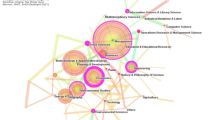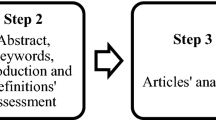Abstract
Research and innovation are attributed a growing role in maintaining global competitiveness; in particular, research advances are seen as important catalysts for innovation and growth. However, our understanding is still limited concerning how important research results are achieved. This is particularly the case for the role of serendipity, where discoveries or the path towards them are unexpected. This paper explores through the use of a narrative approach the role of planned and unplanned factors and presents elements for understanding how and when serendipity occurs in highly cited research. In this explorative study, we have interviewed 12 first authors, each of whom has played a key role in a highly cited piece of research. Their own perceptions of how research progressed, key turning points, and conditions for the research are important in illustrating what motivates and influences the researchers’ pursuit of new discoveries. The narrative approach, by introducing a temporal element, is both able to characterize the stories behind the advances, including key turning points in achieving research accomplishments, and to analyze cross-cutting themes related to researcher behavior and environment for the research.
Similar content being viewed by others
Notes
For example, H. Zuckerman, S. and J. Cole, R. Andrews, B. Barber and W. Hagstrom.
Irving Langmuir, address to the G.E. Research Colloquium (December 1951), partly paraphrased and partly quoted in G.E. Shareholders’ Quarterly (25 July 1952). Taken from Merton and Barber (2004), pp. 200-201.
This choice was made in order to examine the most recent papers possible (at the time of case selection). However, this choice of three-year citation windows does have the drawback that we do not select any papers that are slow to be cited and only become highly cited after 5 or more years.
References
Callaway, E. (2015). Young scientists go for fresh ideas: analysis of millions of papers finds that junior biomedical researchers tend to work on more innovative topics than their senior colleagues do. Nature, 518(7539), 283–285.
Czarniawska, B. (2004). Narratives in social science research. Sage.
Fisher, W. R. (1987). Human communication as narration: Toward a philosophy of reason, value, and action. South Carolina University Press.
Hagstrom, W. O. (1965). The Scientific Community. New York: Basic Books.
Heinze, T., Shapira, P., Rogers, J. D., & Senker, J. M. (2009). Organizational and institutional influences on creativity in scientific research. Research Policy, 38, 610–623.
Hemlin, S., Allwood, C. A., & Martin, B. R. (2008). Creative knowledge environments. Creativity Research Journal, 20(2), 196–210.
Labov, W. (1972). Sociolinguistic patterns. Philadelphia: University of Pennsylvania Press.
Merton, R. K. (1957). Priorities in scientific discovery: A chapter in the sociology of science. American Sociological Review, 22(6), 635–659.
Merton, R. K., & Barber, E. (2004). The travels and adventures of serendipity: A study in the sociological semantics and the sociology of science. Princeton: Princeton University Press.
Murayama, K., Nirei, M., & Shimizu, H. (2015). Management of science, serendipity, and research performance: Evidence from a survey of scientists in Japan and the U.S. Research Policy, 44, 862–873.
OECD. (2014). Promoting research excellence: New approaches to funding. Paris: OECD.
Polkinghorne, D. E. (1988). Narrative knowing and the human sciences. Suny Press.
Roberts, R. M. (1989). Serendipity: Accidental discoveries in science. Wiley.
Schneider, J. W., & Costas, R. (2017). Identifying potential “breakthrough” publications using refined citation analyses: Three related explorative approaches. Journal of the Association for Information Science and Technology, 68, 709–723.
Stanley, K. O., & Lehman, J. (2015). Why greatness cannot be planned. The myth of the objective: Springer.
Stephan, P. E. (2010). The economics of science. Handbook of the Economics of Innovation, 1, 217–273.
Sørensen, M. P., Bloch, C., & Young, M. (2016). Excellence in the knowledge-based economy: from scientific to research excellence. European Journal of Higher Education, 6(3), 217–236.
Tijssen, R., Visser, M., & van Leeuwen, T. (2002). Benchmarking international scientific excellence: Are highly cited research papers an appropriate frame of reference? Scientometrics, 54(3), 381–397.
Yaqub, O. (2018). Serendipity: Towards a taxonomy and a theory. Research Policy, 47(2018), 169–179.
Young, M. (2015). Shifting policy narratives in Horizon 2020. Journal of Contemporary European Research, 11, 16–30.
Young, M., Sørensen, M. P., Bloch, C., & Degn, L. (2017). Systemic rejection: political pressures seen from the science system. Higher Education, 74(3), 491–505.
Acknowledgements
We are grateful to Sarah de Rijcke and Thomas Franssen for their help in conducting a number of the interviews for this study and for fruitful discussions on earlier versions of the paper.
Author information
Authors and Affiliations
Corresponding author
Additional information
Publisher’s Note
Springer Nature remains neutral with regard to jurisdictional claims in published maps and institutional affiliations.
Rights and permissions
About this article
Cite this article
Bloch, C., Sørensen, M.P. & Young, M. Tales of Serendipity in Highly Cited Research: an Explorative Study. J Knowl Econ 11, 1596–1613 (2020). https://doi.org/10.1007/s13132-019-00625-0
Received:
Accepted:
Published:
Issue Date:
DOI: https://doi.org/10.1007/s13132-019-00625-0




